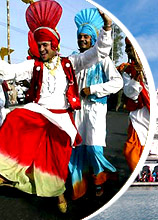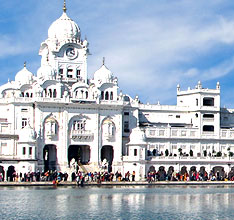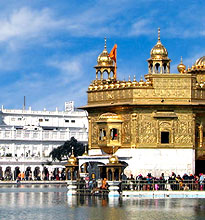 Time: 14th January (Makar Shankranti)
Time: 14th January (Makar Shankranti)Place: Muktsar
Significance: Tribute is paid to Guru Gobind Singh and his forty brave followers
Highlights: Devotees take bath in the sacred tank, followed by the procession to the three holy mounds. Cultural programs present additional attraction.
Muktsar fair is one of the largest Sikh fairs held in Punjab. The fair is held in the middle of January i.e. on the Makar Sankranti day, which falls on January 14. As The fair derives its name from the forty Mukhtas of Guru Gobind Singh who died a valiant death in the Battle of Khidrana. The fair is organized in the Muktsar district of Punjab, to pay tribute to Guru Gobind Singh and his followers. Let us explore all about the Muktsar Maghi Fair of Punjab.
History
Muktsar Maghi Fair commemorates the battle fought by Guru Gobind Singh in 1705-06, against the imperial forces of Mughal rule. The Guru was defeated in the battle, but managed to escape. However, his followers were not as fortunate and were cut into pieces. Guru disposed off his followers’ bodies with the usual rites, declaring that they have attained salvation. He also said that his followers who would bathe in the Holy Pool on the same day would also attain salvation. Later, Maharaja Ranjit Singh dug a fine tank on this spot and called it, Muktsar (the pool of salvation).
Proceedings
Muktsar Fair lasts for three days and attracts a large crowd. On the first day, the worshippers bathe in the sacred tank. There is a procession (mohalla) organized on the second day, to the three holy mounds that lie to the northwest of the town. The three holy mounds are Rikab Sahib, Tibbi Sahib and Mukhwanjana Sahib. Rikab Sahib is the mound formed out of a handful of earth taken from the tank by the faithful and thrown there. It commemorates the spot where the Guru's revolt began. The procession begins from the Rikab Sahib and proceeds to the slope of the Tibbi Sahib, which is crowned with a Gurudwara. Tibbi Sahib is the mound where Guru Gobind Singh stood and aimed his arrows at the Imperial forces.
Finally, the devotees proceed to the Mukhwanjana Sahib, where it is believed that Guru had cleaned his teeth with a tooth-stick. Devotees offer their prayer here and then return. On their return, the devotees visit the Tambu Sahib, where the Guru's tent is said to have been pitched before the fight started; the Shahid Ganj, which is the Samadhi of the forty martyrs; and the Darbar Sahib, where the Guru held his Darbar after the cremation of the slain. Cultural programs are also organized, which add fun to the historic dimension of the fair. Traditional songs and dances form the main features of the programs.











